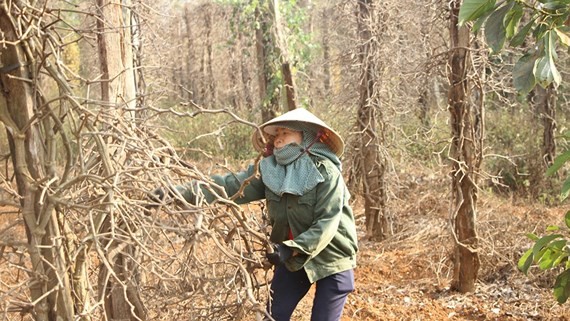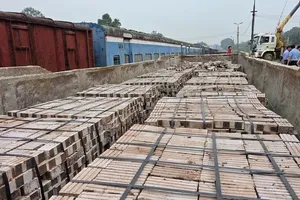
Several pepper plantations in Chu Se and Chu Puh districts in Gia Lai Province are now left with wooden poles alone as pepper plants were all dead because of diseases.
Mr. Pham Van Thuong, a farmer in Thien An Hamlet in Ia Blu Commune of Chu Puh District, said that his family’s pepper plantation has an area of 2,500 square meters with about 1,000 poles of pepper plants. Earlier, his pepper plantation developed healthily and produced lots of peppercorns. However, in 2016, all of his pepper plants suddenly died despite his effort to save them. His family is now in debt of VND200 million – the amount of money his family borrowed from relatives to invest in the pepper plantation.
Mr. Le Quang Vang, vice chairman of the People’s Committee of Ia Blu Commune, said that when the price of black pepper was high, farmers grew pepper massively. Especially, at its peak in 2014, the area of pepper was up to 1,000 hectares. However, after that pepper plants gradually died. By the end of 2018, there were around 100 hectares of pepper plants in the commune but productivity was low. This dry season these remaining pepper plantations are on the verge of elimination.
At Nam N’Jang Commune in Dak Song District of Dak Nong Province, as pepper plants have mostly died farmers have been having to sell their land, houses and poles to make up for losses. Ms. Pham Thi Dao in Dak Lu Hamlet in Nam N’Jang Commune said that she had grown pepper plants on an area of 13 hectares with 16,000 pepper poles which yielded 30-35 tons of peppercorns each crop. However, her pepper plants have all died in the past two years. So now she has to sell pepper poles to pay for the interest of a loan of VND2.5 billion that she borrowed to invest in the pepper plantation.
Mr. Trinh Duc Anh, chairman of the People’s Committee of Nam N’Jang Commune, said that the fact that pepper plants died while the price of pepper dropped drastically has caused several households in the commune to be deep in debt. It is estimated that 80 percent of households growing pepper in the commune owe banks money.
Figures by local authority showed that by the end of last year, more than 1,800 hectares of pepper plants were dead and more than 2,600 hectares were infected with diseases in Dak Nong Province. In Dak Lak Province, more than 2,000 hectares of pepper plants have died by the beginning of this year. The area of dead pepper plants was more than 4,900 hectares last year in Gia Lai Province.
At the same time, the price of pepper continuously declined heavily, putting huge burden on pepper farmers. Peppercorns are all red at several pepper plantation but farmers do not bother to harvest them as the money they collect from selling pepper cannot cover labor costs. According to Mr. Nguyen Van Hop, head of the Department of Agriculture and Rural Development of Chu Se District of Gia Lai Province, the price level of around VND42,000-VND44,000 per kilogram is the lowest level in years and pepper is not profitable. Farmers have switched to grow passion fruits, Inca peanuts or fast growing crops in order to improve the soil.
As for the area of pepper plants that are ready for harvest, due to low price, farmers at some places harvest both red and green peppercorns so as to reduce labor costs. This will lead to poor quality as well as low value of peppercorns.
According to Mr. Ho Phuoc Binh, standing vice chairman of Pepper Association of Chu Se District, a drop in pepper price was forecast by authorities many years ago based on the law of supply and demand. The fact that farmers expanded the pepper growing area massively when the pepper price was high has caused a sudden excessive in pepper supply. Meanwhile, consumption of pepper globally is also no longer as strong as before, thus a sharp decrease in pepper price is unavoidable. Vietnam is the world’s largest black pepper exporter. According to authorities, the remaining supply of pepper in Vietnam and the world is still high. As a result, the price of pepper is likely able to recover in the next 3-5 years.
Dr. Truong Hong, acting director of the Western Highlands Agro-Forestry Scientific and Technical Institute, said that the current situation of provinces in the Central Highlands of Vietnam is a warning for farmers not to expand the crop growing area out of project scope and not in accordance with agricultural industry’s recommendation. In order to deal with the current situation, it is essential to project again the area of pepper plants, replace the area of dead pepper plants by other effective and suitable crops. Farmers should apply advanced technology in farming such as organic farming in order to protect the environment and the soil.
With the current price level, farmers will not have profits or even suffer losses if they continue to pump more money into pepper plantation. At places that are suitable for pepper plants to develop, farmers should try to keep and take care of their pepper plantations and apply advanced technology to prevent diseases. Agricultural and local authorities should train and guide farmers in growing and preventing diseases as well as encourage them to join cooperatives or groups that produce clean farm products so as to solve the issue of consumption for their produce.
According to Mr. Le Quang Vang, vice chairman of the People’s Committee of Ia Blu Commune, around 1,400 laborers have left the town to find jobs in other places in order to earn money to pay for the interest of loans they borrowed banks to invest in pepper plantations. There are 40 households having left their town because their pepper plants were all dead and their houses were seized by banks. It is estimated that farmers owe banks above VND250 billion, of which most of them are unable to pay back.
























